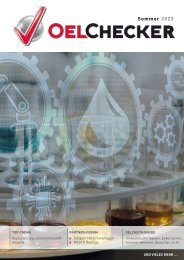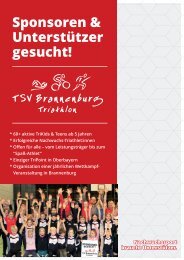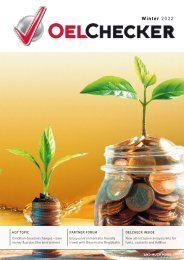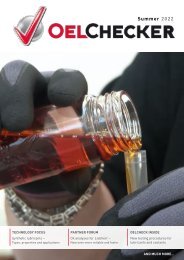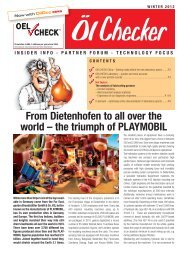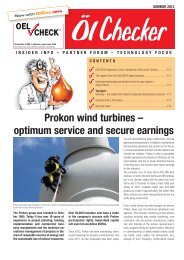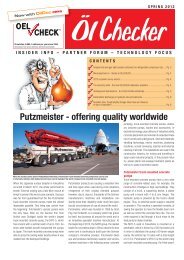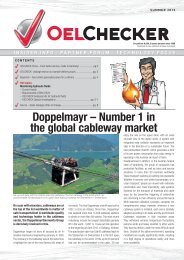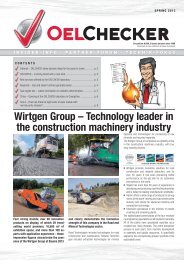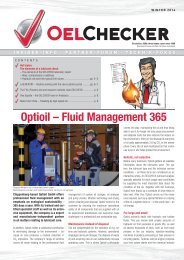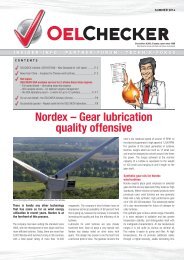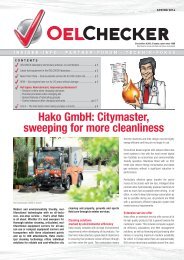OELCHECKER - Winter 2015
> The intelligent giants from Konecranes > OELCHECK innovation – The IR Index sets standards > Six jokers in the pack – New complete kits for wind turbines > New in the laboratory – Oxidative stability of lubricating greases > News from China – MAN Diesel & Turbo PrimeServ > Hot Topics: Higher sustainability and energy efficiency thanks to modern lubricants > Sustainability – the potential is still far from being fully realised > Higher energy efficiency – just a promise or a reality? > Success with quality – OELCHECK passes surveillance audits
> The intelligent giants from Konecranes
> OELCHECK innovation – The IR Index sets standards
> Six jokers in the pack – New complete kits for wind turbines
> New in the laboratory – Oxidative stability of lubricating greases
> News from China – MAN Diesel & Turbo PrimeServ
> Hot Topics: Higher sustainability and energy efficiency thanks to modern lubricants
> Sustainability – the potential is still far from being fully realised
> Higher energy efficiency – just a promise or a reality?
> Success with quality – OELCHECK passes surveillance audits
Create successful ePaper yourself
Turn your PDF publications into a flip-book with our unique Google optimized e-Paper software.
WINTER <strong>2015</strong><br />
Circulation: 9,500; three issues a year since 1998<br />
Download at www.oelcheck.de/news-downloads<br />
CONTENTS<br />
OELCHECK innovation – The IR Index sets standards ............................... p. 3<br />
Six jokers in the pack – New complete sets for wind turbines .................... p. 4<br />
New in the laboratory – Oxidative stability of lubricating greases ............... p. 4<br />
News from China – MAN Diesel & Turbo PrimeServ ................................. p. 5<br />
Hot topics:<br />
Higher sustainability and energy efficiency thanks to modern lubricants<br />
– Sustainability – the potential is still far from being fully realised<br />
– Higher energy efficiency – just a promise or a reality? ....................... p. 6-8<br />
Success with quality – OELCHECK passes surveillance audits ................. p. 8<br />
The intelligent giants<br />
from Konecranes<br />
Strongly service-oriented, the company is represented<br />
across 26 locations in Germany alone. More<br />
than 250 qualified service engineers are on hand<br />
every day with their perfectly equipped service vehicles<br />
to be deployed to customers. The specialists<br />
carry out inspections, preventive maintenance and<br />
repairs. On board the service vehicles are the practical<br />
analysis kits from OELCHECK. Oil analyses are<br />
an important part of the maintenance concept for<br />
all gears in hoists and crane systems of various<br />
types.<br />
Typically Konecranes: intelligent machines combined with intelligent services<br />
Konecranes is among the world‘s leading<br />
manufacturers of hoists and cranes. The<br />
„Equipment“ division develops and produces<br />
industrial and heavy-duty cranes,<br />
power plant cranes, port technology and<br />
heavy-duty forklift trucks.<br />
Customers include companies in the production,<br />
energy and process industries, shipyards, ports<br />
and freight terminals. With the aim of „Lifting Busi-<br />
nesses“, Konecranes is committed to lifting loads –<br />
and to raising the productivity of its customers.<br />
Konecranes was one of the first companies to actively<br />
focus on the area of preventive maintenance<br />
and to develop modern, innovative service products<br />
and diagnostics. In the service division, the company<br />
offers services for hoists, cranes and machine<br />
tools for all manufacturers. Intelligent machines<br />
working hand in hand with intelligent services is<br />
already a reality at Konecranes.<br />
Gears made by Konecranes<br />
The production of crane systems has a high production<br />
depth. In addition to the often gigantic<br />
welded structures, Konecranes also produces all<br />
gears, including gear parts. In a gantry crane, for<br />
example, there are at least three, usually six hoist,<br />
winch and crane trolley gears. Gears with an output<br />
power of up to 580 kW and an output torque of up<br />
to 380,000 Nm are used here. Gears are treated<br />
with mineral-oil-based CLP industrial gear oils in<br />
viscosity groups 100, 150 or 220, depending on<br />
the type of gears.<br />
The oil volume is between 8 and 320 l. Notwithstanding<br />
the oil analyses, the oil is changed at intervals<br />
of two or five years depending on the type<br />
of gears, the engine group, and the specific system.
In the OELCHECK laboratory, all testing devices are precisely tailored<br />
to the specific requirements of inspecting lubricants. Installation and<br />
calibration of a new device is highly labour-intensive. Preparation<br />
can take a considerable amount of time. The standard of our equipment<br />
and workflows, as well as the standards we set for ourselves, are<br />
nevertheless extremely high. And when a new device is finally put to<br />
use, it is crucial that everything is perfectly adjusted.<br />
We give our all to testing customers‘ lubricants as thoroughly as<br />
possible. However, we would like to find out how satisfied our customers are with our services<br />
by carrying out another large-scale customer survey. This was planned for the autumn of this<br />
year. We consider this type of survey just as critically as we do our testing devices in the laboratory. All<br />
of the parameters must be conducive to obtaining meaningful results. We would like to use our survey<br />
to put our new customer portal www.lab.report, among other things, under the microscope. The portal<br />
allows you to submit and manage samples, as well as control actions, more easily. However, www.lab.<br />
report has only been online for a few months. Our customers should have the opportunity to gain more<br />
experience of using the portal and its many functions before they evaluate it. We would therefore like to<br />
give you some more time and will not be conducting the survey until the spring of 2016. Ultimately our<br />
survey is also a test instrument and should therefore provide evidence as objective and reliable as our<br />
testing devices in the laboratory.<br />
Yours, Barbara Weismann<br />
Oil analyses for even greater safety<br />
Konecranes uses the OELCHECK gear oil analyses<br />
mainly to detect damage at an early stage. Early<br />
detection of any damage to the gears, especially<br />
in hoist gears, is a key factor when it comes to increasing<br />
operational safety. In the worst-case scenario,<br />
unplanned and costly production downtime<br />
is also avoided.<br />
The lubricant analyses are used in preventive<br />
maintenance and CRS (Crane Reliability Survey)<br />
inspections to assess the condition of crane systems<br />
as part of the assessment of the remaining<br />
lifetime. They are an integral part of the „Care“ and<br />
„Commitment“ service programmes. They are also<br />
offered by Konecranes as part of all other service<br />
programmes and for gear overhauls as a separate<br />
product.<br />
The gear oils are checked at least once a year depending<br />
on the utilisation of the hoists and crane<br />
systems. OELCHECK examines the condition of the<br />
lubricants, checking meticulously for signs of possible<br />
wear on gearwheels, roller bearings and seals.<br />
Checks are also made for contaminants from water<br />
from high-pressure cleaners, or dust that can get in<br />
via ventilation filters. An element analysis using ICP<br />
provides information on the possible content of wear<br />
metals and contaminants, as well as the condition of<br />
the oil additives. The PQ index includes all magnetisable<br />
wear particles, regardless of their size. Additive<br />
depletion and oil oxidation are determined by FT-IR<br />
spectroscopy.<br />
Working overhead – the gears of the gantry cranes<br />
are located overhead. Oil samples can be taken easily<br />
thanks to the practical OELCHECK sampling pump.<br />
Planning and inspection with intelligent<br />
service system<br />
Konecranes combines intelligent machines with<br />
intelligent services. An important element of this<br />
is MAINMAN 4, the unique ERP (Enterprise Resource<br />
Planning) system from Konecranes. With<br />
MAINMAN 4, customers benefit from the following<br />
maintenance and inspection features:<br />
• Paperless service for sending inspection reports<br />
• Integrated business and safety reviews<br />
• YourKonecranes.com: a web portal with real-time<br />
access to all systems data and services<br />
performed<br />
• Modern, comprehensive safety reports in which<br />
relevant causes of problems and risks are<br />
highlighted.<br />
All laboratory reports by OELCHECK are integrated<br />
into the ERP system and archived with a commentary<br />
under the respective component. The<br />
intelligent system not only offers detailed insights<br />
into the condition of the machinery, it also allows<br />
routine maintenance work such as adjustments and<br />
lubrication. It is an holistic system offering a range<br />
of services unparalleled in the crane industry.<br />
Konecranes – a global market leader<br />
in Lifting Businesses<br />
The history of Konecranes dates back to 1910, the year the<br />
electric motor repair shop KONE was founded in Finland.<br />
Konecranes was founded as an independent company in<br />
1994 when it separated from the company KONE. Today<br />
Konecranes is a global market leader in Lifting Businesses.<br />
The group employs around 12,000 people at 600 sites<br />
in almost 50 countries.<br />
2<br />
Further information: www.konecranes.de
OELCHECK INSIDER INFO<br />
OELCHECK innovation –<br />
The IR Index sets new standards<br />
In recent years, FT-IR (Fourier Transform Infrared) spectroscopy has become established as one of the most important techniques<br />
for assessing used lubricants. Whether for oils or greases, OELCHECK produces an infrared diagram during every analysis. This<br />
examines possible ageing of the lubricant, detects contaminants and identifies mixture with other types of oil. The analysis of<br />
the IR spectrum informs the diagnosis of the OELCHECK engineers. Every OELCHECK laboratory report includes a diagram of the<br />
infrared spectra of the used lubricant and its fresh counterpart, provided the oil designation has been given. However, extensive<br />
knowledge is required to be able to interpret an infrared spectrum. This is provided in specific OilDoc seminars or as online training.<br />
For those who do not wish to study the subject in quite as much depth, the new IR index from OELCHECK now offers a reference<br />
value to enable a faster understanding when comparing two IR spectra.<br />
OELCHECK is currently the only laboratory that reliably calculates and communicates this value!<br />
The principle of FT-IR spectroscopy is based on<br />
there being different molecules present in the lubricant<br />
which, because of their typical chemical structures,<br />
absorb infrared light to different degrees with<br />
certain wavelengths. Changes in the used oil can<br />
be compared to the fresh oil reference spectrum<br />
and depicted, calculated and interpreted as a deviation<br />
from typical „peaks“ or changes in areas for<br />
certain „wave numbers“.<br />
The infrared spectrum of a sample provides information<br />
on ageing-related changes in the oil and<br />
contaminants from water, soot, other oil or fuel<br />
compared to the spectrum of a corresponding fresh<br />
oil or reference oil. Every spectrum is as unique as<br />
an individual human fingerprint.<br />
The diagram of the IR spectra of the used and<br />
corresponding fresh oil have been provided on the<br />
OELCHECK laboratory reports as standard for years.<br />
However, this service is now being enhanced with an<br />
essential component. OELCHECK has installed two<br />
new additional „PerkinElmer Spectrum Two“ testing<br />
devices in the laboratory. As state-of-the-art devices,<br />
they are not only considerably more compact than<br />
their predecessor models, but with an integrated autosampler<br />
they also work faster and calculate an IR<br />
index using OELCHECK-enhanced software which is<br />
now given in all laboratory reports. This means that<br />
OELCHECK is currently the only laboratory that reliably<br />
calculates and communicates this value!<br />
The IR index allows a faster understanding<br />
of the findings of the respective IR spectrum.<br />
The higher this is, the smaller the changes in<br />
the used oil sample are in relation to the fresh<br />
oil or reference sample.<br />
When considering the IR index in question, it is<br />
essential that the oil type is known. While a value<br />
below 99 could be cause for concern in a turbine oil,<br />
for example, the limit for an engine oil is around 85.<br />
The IR index is calculated using linear regression. This<br />
can be represented visually in a diagram. For each<br />
wave number, the absorption in the fresh oil is plotted<br />
against the x-axis and in the used oil against the y-axis.<br />
When there is absolute correlation, this produces a<br />
straight line. (However, particular regions, such as<br />
those with extremely high absorption resulting from<br />
hydrocarbon bases, are not relevant and are excluded.)<br />
The closer the points being compared are to the<br />
straight lines, the lower the deviations. Given that a<br />
graph is difficult to read, we do not include one in the<br />
laboratory reports, but instead show the two spectra<br />
in a diagram (which can also be downloaded and enlarged<br />
at www.lab.report). We also give the practical<br />
numerical value of the IR index in the laboratory report<br />
as a correlation coefficient.<br />
Two examples are shown on the right:<br />
Above: The IR index of a used motor oil is only<br />
70.38! The two spectra deviate significantly from<br />
each other in some regions as a result of high<br />
oxidation, nitration and sulfation of the used oil.<br />
The regression line illustrates this accordingly.<br />
The lubricant has aged considerably and must<br />
be changed as a matter of urgency. The cause<br />
of the extreme ageing must also be identified and<br />
remedied.<br />
Below: Here everything is as it should be. The<br />
IR index is 99.90. The spectra virtually coincide.<br />
Correspondingly, there is virtually no change in<br />
the used oil compared to the fresh oil. Further<br />
use may still be considered even if the values for<br />
the additives and wear elements and the viscosity<br />
values fall within the permitted limits.<br />
OELCHECK customers benefit from our experience, unique service and pioneering innovations. For example,<br />
as the first laboratory for lubricant analysis, we introduced the PQ index back in 1994. Unlike with<br />
elemental analysis using ICP or RDE, with the PQ index magnetisable iron particles are also recorded,<br />
regardless of their size. As a key element in the early detection of wear, today the PQ index is a universal<br />
standard. OELCHECK has been performing IR spectroscopy for all samples for 25 years and now has<br />
approximately 2.5 million spectra in its database. For 15 years the spectra have been printed in the<br />
laboratory report and can be downloaded from the customer portal.<br />
With the new IR index, OELCHECK is once again setting standards, providing an important value with a<br />
practical application for faster assessment of the two IR spectra being compared. The new IR index is<br />
not a substitute for the assessment of the spectra by OELCHECK diagnostic engineers. Rather, users of<br />
our laboratory reports can now use the given values of the IR index to gain a clearer understanding, as<br />
opposed to making a time-consuming visual comparison of the spectra. This will allow you to see at a<br />
glance whether the values of the used oil and fresh oil still correspond to one another to such an extent<br />
that no oil change is required.<br />
3
OELCHECK INSIDER INFO<br />
Six jokers in the pack –<br />
The OELCHECK all inclusive kit for wind turbines<br />
QUOTATIONS & ORDERS<br />
Tel. +49 8034-9047-250 – akv@oelcheck.de<br />
Nowadays wind<br />
power can and must be able to keep pace<br />
with conventional power plant technology in<br />
terms of production and operating costs.<br />
Maximum availability is also essential. Optimised,<br />
proactive maintenance plans are the<br />
key to success, and lubricant analysis plays an<br />
important role in this.<br />
While it used to be the main gearbox that took centre<br />
stage in oil analysis, nowadays the hydraulics,<br />
grease-lubricated main, blade and generator bearings,<br />
as well as the pitch gears in offshore plants,<br />
are also monitored.<br />
For every one of these components and its lubricant,<br />
OELCHECK offers analysis kits with the appropriate<br />
analysis scope. However, it is desirable to have as<br />
little baggage as possible when ascending to the<br />
lofty heights of a wind turbine. Thanks to the new<br />
all inclusive sample kit for wind turbines<br />
from OELCHECK, the work of the service<br />
engineers is made considerably easier.<br />
Rather than having multiple containers with<br />
different coloured caps, the engineers now<br />
have just one type of sample bottle. The bottles have<br />
been budgeted at the same price. The same type<br />
of kit can be used for the lubricants that are being<br />
inspected according to requirements, regardless of<br />
the wind energy plant component.<br />
When the samples arrive in the laboratory, the mint<br />
green cap signals „Attention! Sample from a<br />
wind turbine!“. The bottles can hold gear or hydraulics<br />
oils, as well as grease samples. All of the<br />
important information relating to this is provided by<br />
the coded Sample Information Form. As before, the<br />
scopes of analysis are tailored precisely to the respective<br />
lubricant and component.<br />
Six sample containers in the analysis box at a unit price:<br />
Six jokers for inspecting gear oils, hydraulic fluids and<br />
greases from wind turbines<br />
The service engineers can also make their work even<br />
easier by entering the samples into our customer<br />
portal at www.lab.report, either on their PC or<br />
via the QR code on the wind turbine. The laboratory<br />
number under which they have entered the samples<br />
is stuck onto the container. The Sample Information<br />
Form do not need to be completed by hand and<br />
enclosed.<br />
Our customer service team will be happy to advise<br />
you and will prepare an individual quotation according<br />
to your requirements.<br />
NEW! Determining the oxidative stability of lubricating greases<br />
OELCHECK offers special analysis kits for the<br />
inspection of lubricating greases and implements<br />
for grease sampling (find out more in the<br />
<strong>Winter</strong> 2012 issue of <strong>OELCHECKER</strong>). An increasing<br />
number of lubricating greases are used for long-term<br />
or even lifetime lubrication. Grease manufacturers and<br />
OEM design engineers in particular should know the<br />
oxidative stability of the relevant greases in advance.<br />
After all, even long-term greases age. High temperatures<br />
and ambient oxygen above all cause the grease<br />
to oxidise.<br />
It is not always possible to assess a fresh grease in<br />
a complex roller bearing test, for example the FE 8<br />
with a test run with 10 bearings. Moreover, it is often<br />
difficult to find out comparable values, especially of<br />
lubricating greases sold outside of Germany.<br />
To ensure that consistent information on oxidation-related<br />
relubrication intervals can be<br />
provided, from now on OELCHECK will also test<br />
the oxidative stability of lubricating greases.<br />
The test is conducted in accordance with the guidelines<br />
of ASTM D942 and serves, among other things,<br />
as a means of comparison and quality control of fresh<br />
greases.<br />
For this test, RPVOT test equipment, which is used<br />
routinely to determine the oxidative stability of turbine<br />
oils, was fitted with an additional piece of apparatus in<br />
the OELCHECK laboratory for taking grease samples.<br />
In the test, the lubricating grease is<br />
subjected to pure oxygen inside<br />
a hermetically sealed pressure<br />
chamber at an elevated temperature.<br />
The oxygen is consumed by<br />
the process of oxidation, which<br />
in turn lowers the pressure in the<br />
pressure chamber. Given that<br />
there are oxidation inhibitors in<br />
the lubricating grease, this drop<br />
in pressure can be prevented<br />
for as long as the additives can<br />
buffer the oxygen.<br />
Ageing is simulated for a specified<br />
time (typically 100 or 200 h).<br />
The result is a drop in pressure<br />
during this period. The oxidative<br />
stability of the lubricating grease<br />
as a whole is determined, not just<br />
that of the separated base oil. The<br />
values that are ascertained from this process indicate<br />
the oxidative stability of the grease in its practical application.<br />
The longer it takes for the drop in pressure<br />
to register, the better equipped the grease is against<br />
premature ageing.<br />
In five Petri dishes, each with a diameter of 40 mm, 4 g of grease are<br />
weighed out and spread evenly. Once they have been placed securely in<br />
a rack, the Petri dishes are put into the pressure chamber. After repeated<br />
injections of oxygen to pressurise the air, the pressure chamber is set to a<br />
pressure of 110 psi (approx. 7.5 bar) and a temperature of 99 °C.<br />
The pressure is then recorded continually for the duration of the test.<br />
4
在 做 什 么 NEWS FROM CHINA 在 做 什 么<br />
MAN Diesel & Turbo – PrimeServ for China<br />
Inserting a rotor into the plain bearing<br />
of this helps customers to optimise the availability of<br />
their systems and save money.<br />
In China customers also receive one-stop service with MDT PrimeServ (e.g. assembly of a steam turbine).<br />
MAN PrimeServ is the service brand of<br />
MAN Diesel & Turbo (MDT) and is synonymous<br />
worldwide with first-class aftersales<br />
service – 24 hours a day, 365 days<br />
a year. MAN PrimeServ has a global<br />
presence with more than 115 subsidiaries<br />
in all key markets and relevant ports.<br />
The company is of course also active in<br />
China, with MDT PrimeServ China being<br />
developed into an increasingly independent<br />
organisational entity. This is due to<br />
incorporate all areas of the service division,<br />
from sales, project management,<br />
technical consultancy, inspections and<br />
repairs in the workshops to planned<br />
and, in particular, emergency services<br />
on-site. Operations are currently based<br />
at two sites in Shanghai and Peking. The<br />
company also runs a comprehensive service<br />
workshop in Changzhou in the east<br />
of the country.<br />
MDT PrimeServ China focuses on gas and steam<br />
turbines, axial and radial compressors, geared<br />
compressors, screw compressors and expanders.<br />
Around 80 service personnel work solely on maintaining<br />
turbo machines. Just as they do in Europe,<br />
the highly qualified service team offers an outstanding<br />
service and first-class technical support.<br />
With MDT PrimeServ, customers receive „one-stop<br />
service“: an outstanding global network, technical<br />
expertise, optimised processes and a strong service<br />
mentality.<br />
There is close cooperation with the development sites<br />
in Europe. After all, only state-of-the-art, tailor-made<br />
solutions are supplied by MDT in China too. Systematic<br />
use of original spare parts also contributes to a<br />
long service life and efficient operation of the systems.<br />
The specialists from MDT PrimeServ China carry out<br />
inspections and repairs. They modernise, relocate and<br />
expand existing systems. And for emergency cases<br />
they are on call around the clock.<br />
Condition-based monitoring<br />
For operators of turbo machines in China, a service<br />
package is particularly important when it comes<br />
to overhauling complete systems. With „condition-based<br />
monitoring“, MDT PrimeServ China<br />
plans the machine overhaul in collaboration with<br />
you. This also involves ongoing monitoring of certain<br />
operational parameters, such as the oil and<br />
steam quality, vibration behaviour using vibration<br />
analysis, and bearing vibrations and temperatures<br />
using online monitoring.<br />
Hot on the trail of the latest trends with<br />
oil analyses<br />
Up to 30,000 litres of turbine oil of ISO-VG 46<br />
are used in a standard system, often over several<br />
years. However, only oils that comply with the<br />
specifications stipulated by MDT‘s own laboratory<br />
in Oberhausen can be used for this. The lifetime<br />
of the turbine oil is ultimately not only dependent<br />
on the choice of oil, but on oil monitoring, servicing<br />
and cleaning. Turbine oils must therefore be monitored<br />
carefully. For around two years, OELCHECK<br />
lubricant analyses have been the first choice for<br />
routine analyses in China.<br />
The specific range of analyses for the turbine oils<br />
was decided upon jointly by the MDT laboratory, the<br />
technical consultants in Oberhausen and OELCHECK.<br />
As well as monitoring the antioxidants, contaminants<br />
are also detected at an early stage. This is important<br />
because even slight changes can adversely affect oil<br />
ageing, demulsibility capacity, wear protection and<br />
foaming characteristics of turbine oils.<br />
Provided that the operating conditions do not change<br />
significantly, the oil analyses also provide important<br />
trend data which can be used to predict the remaining<br />
lifetime of the oil and to plan necessary oil maintenance<br />
in-time and proactive. Ideally the turbine<br />
oils should be analysed regularly in an OELCHECK<br />
laboratory at intervals of 3 to 6 months, with additional<br />
feedback from MDT PrimeServ. In China, our<br />
laboratory in Guangzhou is responsible for this – another<br />
advantage for MDT PrimeServ China and its<br />
customers!<br />
View of a 6.9 MW gas turbine<br />
Regular diagnostic assessments, including endoscopies<br />
using a borescope, are also conducted on-site. All<br />
The MAN PrimeServ China head office in Shanghai<br />
5
TECHNOLOGY FOCUS<br />
Higher sustainability and energy efficiency<br />
thanks to modern lubricants –<br />
just a promise or already a reality?<br />
The two catchwords „energy efficiency“ and „sustainability“ have become almost overused whenever newly developed lubricants<br />
are unveiled. But there is still progress to be made in the manufacturing industry when it comes to sustainability, and increasing<br />
the energy efficiency of systems and machinery is an important part of this. While it is hard to imagine, the potential for this is<br />
still far from being fully realised. It is not only the lubricants used that have an important role to play in this optimisation process,<br />
but the consistent monitoring of them through oil analyses. But what promises can be made that are actually realistic? How can<br />
lubricants‘ contribution to energy efficiency and sustainability even be quantified? And how should oils and greases be designed<br />
to bring about the positive effects that are expected?<br />
Sustainability – the potential is still far<br />
from being fully realised<br />
Extending the lifetime of components, as well as<br />
that of oil charges, has taken on the sound of a<br />
mantra! Modern lubricants should be designed<br />
increasingly with the purpose of remaining usable<br />
for longer. The mineral oil industry is looking increasingly<br />
to better, often synthetic base oils as the<br />
simplest way of achieving this aim. In contrast to<br />
pure mineral oil refining, the molecular structures<br />
of the base oils are changed during the production<br />
process in such a way as to create positive characteristics,<br />
like an increased ageing stability or<br />
improved viscosity-temperature behaviour. Modern<br />
high-potency oxidation inhibitors based on salicylates,<br />
phenols or amines also help to retard the<br />
ageing process of the lubricants during use. Nowadays<br />
it is possible even for some high-performance<br />
industrial gear and hydraulic oils, as well as turbine<br />
oils, to remain in use for over 50,000 operating<br />
hours, or around 10 years. Nevertheless, even the<br />
best long-term lubricant has its limits.<br />
In contrast to the aim of achieving longer lifetimes,<br />
many lubricants are still being changed even when<br />
their potential is far from being fully exploited. This<br />
means that enormous potential is being destroyed<br />
every year. If the approximately 1 million tonnes of<br />
lubricant used in Germany alone was only replaced<br />
when it was technically necessary, around 30% of<br />
that, or 300,000 tonnes/350 million litres, could<br />
be saved every year. Although more and more<br />
companies are managing their oil change intervals<br />
using trend analyses, only a fraction of this enormous<br />
savings potential is being realised.<br />
However, rather than changing oils at fixed intervals,<br />
OEMs are now increasingly recommending<br />
that oils be changed<br />
according to their condition.<br />
For this purpose, many machine<br />
manufacturers offer<br />
OELCHECK analysis<br />
kits, often as part<br />
of their spare<br />
parts ranges.<br />
Usage time of<br />
the oil charge<br />
in h<br />
Conventional<br />
mineral oils<br />
The analyses not only allow oil changes to be made<br />
on a condition-dependent basis, they also allow<br />
damage to be detected at an early stage, thereby<br />
ensuring fail-safe operation of machines and systems.<br />
The monitoring of oils and motors in biogas<br />
plants, for example, which are exposed to particular<br />
risk on account of the often variable, sometimes<br />
aggressive gas compositions, prove how well this<br />
can work. Lubricant analyses are also the indispensable<br />
method of choice when it comes to using new<br />
types of lubricant for which there is no empirical<br />
evidence to indicate a possible application period.<br />
Higher energy efficiency –<br />
just a promise or a reality?<br />
For private individuals, good thermal insulation<br />
reduces household heating costs, while service<br />
technicians are promised that the energy consumption<br />
of their vehicles and machines can be reduced<br />
by using selected lubricants. However, given the<br />
vague nature of these promises, they are not worth<br />
very much. Ultimately the much-touted lubricants<br />
tend to be considerably more expensive; buying<br />
them should be economically profitable and result<br />
in a marked reduction in energy costs.<br />
Temperature-dependent oil oxidation<br />
Hydrocracked<br />
oils<br />
PAO synthetic<br />
oils<br />
Ester-based<br />
synthetic oils<br />
Glycol-based<br />
synthetic oils<br />
40,000 40 50 60 60 65<br />
30,000 45 55 65 65 70<br />
20,000 50 60 75 75 75<br />
10,000 60 70 85 85 90<br />
5,000 70 80 100 100 105<br />
2,500 80 90 115 115 120<br />
1,250 90 100 130 130 135<br />
675 100 110 145 145 150<br />
In an ideal case, conventional lubricants can remain in use in industrial applications at 40°C for 40,000 hours<br />
(approx. five years in three-shift operation) without needing changed as a result of oxidation and ageing. The<br />
temperature threshold for oxidation-related changes is higher for other types of oils.<br />
As a rule of thumb, for every temperature increase of 10°C the oxidation-related lifetime of oils in Groups I<br />
and II halves. For synthetic oils, the baseline temperature is higher and the oxidation-related lifetime halves<br />
for every increase of 15°C.<br />
Before there is a wholesale change in the type of<br />
lubricant used, ideally a single system should be<br />
changed to begin with, whereby the energy consumption<br />
of the system is ascertained under the<br />
same operating conditions and the values from<br />
before and after the oil change are compared.<br />
However, comparing the energy consumption is<br />
not always possible, or may only be possible at<br />
considerable expense. It becomes very tricky when,<br />
for example, lubricant manufacturers claim that the<br />
efficiency of the main gears in a wind turbine, for<br />
instance, will be increased to such an extent that<br />
more electricity will be fed into the grid at the same<br />
wind speed as a result of reduced friction loss in<br />
the gears. The electricity feed-in from an individual<br />
wind turbine is dependent on several factors and it<br />
is difficult to verify that the lubricant has had the<br />
expected effect.<br />
The prospects of increasing the energy efficiency<br />
of engines, hydraulic systems and industrial gears<br />
with lubricants are extremely variable. The extent<br />
of the lubricants‘ influence diverges significantly.<br />
Moreover, every application must be considered<br />
individually.<br />
6
Engines<br />
Efficiency, friction loss and the proportion that can be affected by lubricant<br />
Component Efficiency in % Losses in %<br />
Proportion affected by<br />
oil in %<br />
Spur gears 97 - 98 2 - 3 0.2 – 0.3<br />
Hypoid gears 88 – 94 6 – 14 2 – 4<br />
Bevel gears 92 – 94 6 – 8 2 – 4<br />
Planetary gears 96 – 98 2 – 4 0.5 - 1<br />
FZG automatic gears 83 - 85 15 - 17 3 – 5<br />
7-speed DSG gears 88 – 91 9 - 12 2 – 3<br />
Worm gears 60 – 75 25 - 40 8 - 14<br />
Electric engine 90 – 95 5 – 10 0.05 – 0.1<br />
Hydraulic system 80 – 90 10 – 20 4 - 8<br />
Petrol engine 20 – 40 65 – 85 up to 6<br />
To ensure the safe operation of innovative engines<br />
and fail-safe use of their exhaust gas treatment systems,<br />
appropriately designed engine oils are absolutely<br />
essential. At the same time, they should also<br />
help to reduce fuel consumption. The requirements<br />
for engine oils will be much higher in future. The<br />
latest ACEA and API specifications even include<br />
engine tests which can detect an energy saving.<br />
In practice, when using appropriately designed<br />
engines and under optimal conditions, fuel savings<br />
of between 1.8 % and 5.5 % can be achieved compared<br />
to a reference oil – usually an SAE 15W40 or<br />
20W50 – by switching to another type of oil with a<br />
different viscosity.<br />
In principal, an engine runs more smoothly with<br />
a low-viscosity oil thanks to reduced pump and<br />
splash losses, and therefore also consumes less<br />
fuel. As a result, the trend is toward thinner and<br />
thinner engine oils. For example, an SAE 0W16-<br />
class engine oil has already been designed for one<br />
type of engine, and it is likely that engine oils in SAE<br />
classes 0W12 and 0W8 will soon be available on<br />
the market.<br />
However, there are also limits to this development.<br />
On the one hand, the low-viscosity engine<br />
oil must be able to form a resilient film in order to<br />
reliably protect the moving parts against friction<br />
and wear. On the other hand, there can be problems<br />
with evaporation loss (to find out more see<br />
<strong>OELCHECKER</strong> Spring <strong>2015</strong>), which usually increases<br />
as the viscosity of the base oils decreases. Some of<br />
the engine oil which has evaporated as a result of<br />
increased engine oil temperatures in the oil sump<br />
is led through the crankcase ventilation system<br />
into the air-fuel mixture and burned with it. The<br />
combustion residues can then impair the effect of<br />
catalytic converters or soot filters.<br />
It is also true that the lower the loss of oil due to<br />
evaporation, the lower the oil consumption is and<br />
the more stable its viscosity characteristics are.<br />
However, low-viscosity engine oils tend to display<br />
greater evaporation loss, which can lead to increased<br />
viscosity during operation. The originally<br />
much-praised low-friction characteristics of the oil<br />
therefore decline as a result, while the fuel and oil<br />
consumption increases.<br />
The relatively low-viscosity engine oils in viscosity<br />
class SAE 0W-30 that are currently available on the<br />
market can only be achieved using thinner synthetic<br />
base oils. If the viscosity is to be reduced even<br />
further in future, this will present a particular challenge<br />
for lubricant manufacturers as they will have<br />
to endow these engine oils with characteristics that<br />
will ensure low evaporation loss, as well as all of<br />
the other characteristics that are important for the<br />
safe operation of the engines. However, products<br />
designed in this way will certainly come at a price.<br />
And even the perfect engine oil will only be able<br />
to lower the fuel and oil consumption significantly<br />
if the driving is suitably prudent. It should also be<br />
taken into account that the newly developed oil<br />
types can no longer be used wholesale for older engine<br />
types, as their components are not designed<br />
for such low-viscosity oils.<br />
Hydraulic systems<br />
The performance of hydraulic systems is increasing,<br />
and the systems themselves are getting smaller.<br />
Reduced gap tolerances in valves, pumps and engines<br />
and better surface qualities allow higher operating<br />
pressures and enable system components<br />
to work more precisely. At the same time, ever<br />
increasing system availability, even under extreme<br />
operating conditions, is required.<br />
However, smaller oil charges, higher pressures and<br />
increased operating temperatures create intensified<br />
working conditions which a conventional mineral-oil-based<br />
hydraulic oil in class HLP or HLPD<br />
can barely withstand. All lubricants and power<br />
transmission media also age during their lifetime.<br />
This ageing process is caused in part by oxidation.<br />
High temperatures, long service lives, high pressures<br />
and in some cases even contaminants and<br />
wear particles all accelerate the ageing process. In<br />
order to delay ageing for as long as possible, the<br />
fluids contain antioxidants. However, these can<br />
also decompose during oil use, just like extreme<br />
pressure agents or anti-wear agents. With the addition<br />
of extreme operating conditions, temperatures<br />
increase as a result of power dissipation, which<br />
further accelerates oil ageing. And throughout this<br />
process, the viscosity of the oil also decreases,<br />
which is a key factor affecting the efficiency of the<br />
hydraulic system.<br />
Extensive tests with vane pumps, gear pumps and<br />
piston pumps have demonstrated that the viscosity<br />
of the hydraulic fluid has a considerable effect on<br />
the efficiency of the pump. Its hydraulic efficiency<br />
is dependent on the oil viscosity at the pump inlet,<br />
as well as on the pump speed and pressure. Therefore,<br />
the oil viscosity not only affects the efficiency<br />
of the pump as a whole but the energy consumption<br />
as well. For this reason, the viscosity of the hydraulic<br />
fluid should remain as constant as possible for<br />
the entire period of operation, from start-up right<br />
up to high-load operation.<br />
To ensure this, increasingly hydraulic oils with multi-grade<br />
characteristics of type HVLP or HVLPD are<br />
being used, which, in contrast to HLP oils, have a<br />
very high viscosity index of almost 200. In principle,<br />
these types of oils have a positive effect on energy<br />
consumption because even at temperatures of over<br />
80 °C the minimum viscosity is not exceeded. However,<br />
the relatively high proportion of viscosity index<br />
improvers often present in the multi-grade oils can<br />
impair the air separation ability to such an extent that<br />
cavitation damage starts to appear. To avoid this as<br />
much as possible, hydraulics manufacturers allow<br />
oils that are thinner, with the result that the maximum<br />
permissible temperature for use of these types<br />
of oils must be reduced. This is the only way to be on<br />
the safe side in case of any shearing of the viscosity<br />
index improvers. In practice, the use of these multi-grade<br />
hydraulic oils at low start-up temperatures<br />
is ideal, but at very high operating temperatures they<br />
reach their limits. If the fluid becomes too „thin“, the<br />
hydraulics in construction machinery, for example,<br />
become more difficult to control or start to work<br />
imprecisely.<br />
In an attempt to resolve this dilemma, one of the<br />
leading international additive manufacturers has<br />
designed a special package of hydraulic oil active<br />
agents that is used by a number of lubricant manufacturers.<br />
The ready-made products, which are<br />
usually based on base oils in Groups I or II, meet<br />
the requirements of DIN 51524/3 for HVLP hydraulic<br />
oils. The new technology allows low-viscosity<br />
hydraulic oils to be used over a wider operating<br />
temperature range. This means that the efficiency<br />
of the hydraulic systems is increasing, while the<br />
7
energy consumption of the systems is decreasing.<br />
Compared to a conventional HLP hydraulic oil, the<br />
efficiency of the machine overall can only be increased<br />
by changing the type of oil. In practice, this<br />
means higher hydraulic pressures under full load,<br />
more precise reaction of the system and, above all,<br />
reduced energy consumption, meaning a reduction<br />
in the resultant oil temperature and energy-intensive<br />
cooling output. The manufacturer of the additive<br />
package expects a potential efficiency increase<br />
of around 5% and has demonstrated this in mobile<br />
hydraulic systems with extensive field tests.<br />
Whether using one of the somewhat expensive<br />
fluids included in the innovative additive package<br />
pays off simply on account of the reduced energy<br />
consumption must be considered on a case-bycase<br />
basis.<br />
Gears<br />
Specially designed gear oils are playing an increasingly<br />
important role in increasing the efficiency of<br />
manual transmission, automatic and hypoid vehicle<br />
gears, as well as industrial gears. However, this<br />
cannot be achieved, as is customary with engine<br />
oils and hydraulic oils, by using a thinner oil in<br />
conjunction with structural changes. To improve<br />
the energy efficiency of industrial oils, ingenious<br />
mixtures of different types of base oils and synergetic<br />
additive combinations are used. The gears<br />
ON OUR OWN BEHALF<br />
WINTER <strong>2015</strong><br />
should be able to transmit power as efficiently as<br />
possible. The level of efficiency is equal to the ratio<br />
of output power to drive power, while the output<br />
power equals the difference between drive power<br />
and power dissipation. If at a certain output power<br />
the efficiency level increases and power dissipation<br />
decreases, then less energy is required to drive<br />
the gears. This can be checked, for example, by<br />
measuring the power consumption. Minimising<br />
power dissipation, which is usually reflected by a<br />
lower temperature in a gearbox without additional<br />
cooling, also serves as a guide to increasing energy<br />
efficiency.<br />
A considerable reduction in power consumption<br />
and operating temperature is therefore indicative<br />
of reduced friction, lower power dissipation and<br />
higher gear efficiency. At the same time, this type<br />
of lubricant oxidises considerably less, not least because<br />
of the lower operating temperatures, and can<br />
therefore be used over a longer period.<br />
The effect of a gear oil on gear efficiency can be<br />
examined in practice using, among other things,<br />
the FZG‘s (Gear Research Centre at the Technische<br />
Universität München) tension test. Moreover, the<br />
programme WTplus, developed at the FZG as part<br />
of research projects commissioned by the FVA, is<br />
available for calculating the losses and thermal behaviour<br />
of complete gear systems.<br />
However, the extent to which the respective gear<br />
oil can positively affect the efficiency, and therefore<br />
efficiency rating, of a gear type in practice can only<br />
be determined by practical application, taking into<br />
account the individual operating conditions.<br />
OELCHECK – success with quality!<br />
Compliance with its own guidelines on quality and<br />
organisation of company processes, as well as<br />
the implementation of provisions of national and<br />
international law are an absolute must for us. Our<br />
high quality standards extend to every area of the<br />
company. OELCHECK GmbH‘s quality management<br />
system has thus had DIN EN ISO 9001 certification<br />
since 1995. In 2001, it then secured DIN EN<br />
ISO 14001 certification for its environmental management<br />
system. Selected test procedures have<br />
been accredited in accordance with DIN EN ISO/<br />
IEC 17025 since 2009. The relevant monitoring<br />
audits are carried out at regular intervals. In August<br />
<strong>2015</strong> our two certifications were reviewed by<br />
ALL-CERT Gesellschaft für<br />
Zertifizierungen mbH and<br />
in September the accreditation<br />
was reviewed by the<br />
Deutsche Akkreditierungsstelle<br />
GmbH. The results<br />
were once again impressive!<br />
All monitoring audits<br />
were<br />
successfully<br />
passed!<br />
IMPRINT<br />
OelChecker – an OELCHECK GmbH magazine<br />
Kerschelweg 28 - 83098 Brannenburg · Germany<br />
info@oelcheck.de · www.oelcheck.de<br />
All rights reserved Reproduction is only permitted after<br />
receiving our approval.<br />
Concept and text:<br />
Astrid Hackländer, Marketing & PR, 4600 Thalheim, Austria<br />
www.astridhacklaender.com<br />
Layout and design:<br />
Agentur Segel Setzen, Petra Bots, www.segel-setzen.com<br />
Photos:<br />
OELCHECK GmbH · Konecranes · MDT PrimeServ · fotolia<br />
It is beyond question that gear oil can affect efficiency,<br />
and therefore energy efficiency. However,<br />
it is important to bear in mind the relationships in<br />
individual cases. The percentages that are often<br />
used in lubricant sales to demonstrate savings potential<br />
usually only refer to the efficiency or power<br />
dissipation in the gearing.<br />
Here is a simplified example: if the drive power is<br />
100 kW and the output power is 97 kW, then the<br />
power dissipation is 3 kW or 3% of the drive power.<br />
If a very high reduction in power dissipation of 25%<br />
is achieved, then this 25% does not relate to the<br />
100 kW, but just to the 3 kW of power dissipation.<br />
This means that the gears need 0.75 kW or 750 W<br />
less power. It is doubtful in this case that this 750<br />
W reduction in friction loss would be noticeable in<br />
the form of a lower gear oil temperature. Even here,<br />
the individual conditions must again be considered<br />
carefully and all factors taken into account.<br />
Conclusion<br />
Almost all lubricants can remain in use for longer,<br />
provided their use is accompanied by lubricant<br />
analyses and the length of intervals between<br />
changes are condition-dependent.<br />
Compared to conventional oils, specially designed<br />
lubricants have the ability to positively affect the<br />
energy efficiency of systems. However, every application<br />
must be considered individually and the<br />
cost-benefit ratio carefully calculated. As these<br />
decision-making processes can often be very complex,<br />
the OELCHECK advisory service is on hand<br />
to help.<br />
8




